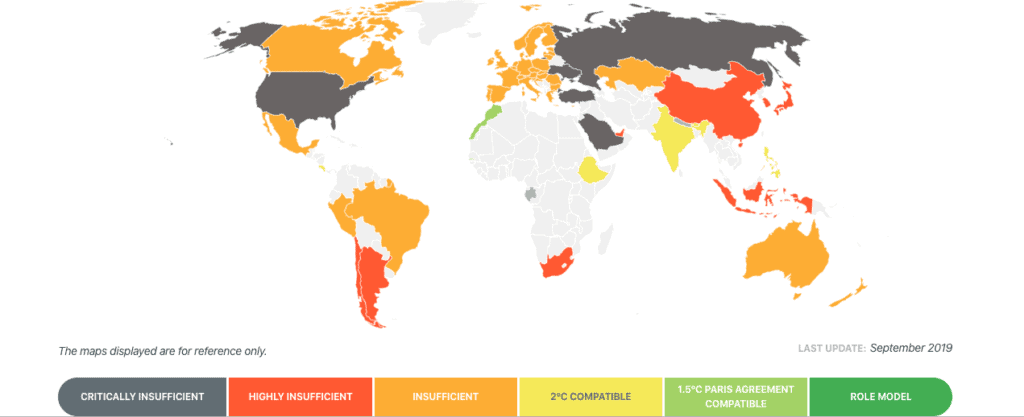More than 175 countries signed in 2016 the Paris Agreement on climate change, seeking to avoid temperature to increase more than two degrees Celsius compared to pre-industrial levels. Now, three years after, the world is far from that target, as countries are not being ambitious enough.

The Paris Agreement allows each country to establish its own climate commitment, specifying how they should reduce their emissions or what timeline should they use. It just asks them to set a target in line with the goal and then when they meet it, to set another and more ambitious one. But despite countries setting their own objectives, they seem to be failing to achieve them.
Climate Action Tracker (CAT) is an international organization that assesses the progress of 32 countries that signed the Paris Agreement and implemented climate pledges. Almost all countries are failing to meet the Paris goals, CAT said, and with the current commitments, the temperature would increase by at least 3.2 Celsius degrees by 2100.
But it gets even worse.
Not only countries are failing on their ambition, but emissions are also actually growing. Research by the Global Carbon Project said emissions rose 2.7% in 2018, mainly because of an increase in oil consumption. A growth of 1.6% was also registered in 2017, ending a three-year period when emissions had slowed down.
The worst performers
Despite the Trump administration announcement to leave the Paris Agreement, it will take at least a full year until the United States actually exits — at least. The earliest withdrawal date on November 4, 2020. This means that at least for now (and potentially even after that, if a new administration is elected), the US is still a part of the Paris Agreement. However, it’s doing quite miserably.
Climate Action Tracker said the US’ emissions levels are too high and its plan to reduce them is “critically insufficient.”
If all countries had the same policies as the US, the world would reach global warming of over four Celsius degrees, CAT said. The US is the second country in the world with the highest greenhouse emissions and is projected to pollute even more by 2030, according to CAT’s analysis.
Russia, South Arabia, Turkey, and Saudi Arabia are also considered “critically insufficient” by CAT, putting the world on a difficult path. Russia was one of the last countries to join the Paris Agreement and file a climate pledge, having so far made little progress in implementing it.
The largest emitter of greenhouse gases in the world, China has also not moved as fast and as ambitious as needed. The country’s actions are seen by CAT as “highly insufficient”, amid a larger coal consumption and rising emissions towards 2030.
Latin American’s largest countries have also failed to be as ambitious as needed. Argentina and Chile’s actions are considered “highly insufficient,” while Brazil and Mexico ranked a step higher as “insufficient” – with actions that would put the world on three Celsius degrees warming.
Europe is not doing all that great. Overall, despite notable efforts, the European Union countries are also falling short of their Paris objectives — though, not by that much. Preliminary data from 2018 show emissions from the combustion of fossil fuels decreased by 2.5% which is positive. However, Europe needs a touch more ambition if they want to assume leadership in addressing their climate targets.
The positive exceptions
In Africa, Morocco and Gambia are the only two countries assessed by CAT that are in line with the Paris Agreement goal of doing all efforts possible to limit the temperature increase to 1.5 Celsius degrees. Morocco is working to have an energy matrix with 42% of renewables by 2020, while Gambia is working on an ambitious reforestation project.
There is also a group of countries doing enough to limit global warming to two Celsius degrees, the second goal mentioned in the Paris Agreement. Bhutan, Costa Rica, Ethiopia, Philippines, and India are all on that list, according to CAT’s analysis.
It’s very significantly that India, the third largest emitter in the world, is on track for a 2 degrees warming. The country is a leader in renewable energy and wants to only sell electric cars by 2030. While instability can still cause major issues in India, the country is on a fairly good path climate-wise.
Looking ahead
While most climate pledges are not ambitious enough, there might be a light at the end of the tunnel. The countries contributions are just a first step as the Paris Agreement says they have to be updated every five years – and when updated they always have to be more ambitious.
This year at the Conference of the Parties (COP25) in Madrid countries will finish the rulebook of the Paris Agreement and will start discussing their new contributions, which are due in 2020 ahead of COP26. Environmental organizations are pushing countries to aim at carbon neutrality – no emissions – by 2030.
But this will be challenging. According to Climate Watch Data, a group of 79 countries has said to be working on updating their climate pledges by 2020. But that group represents only 9.5% of all global emissions, which means further action is needed by the main polluters.


